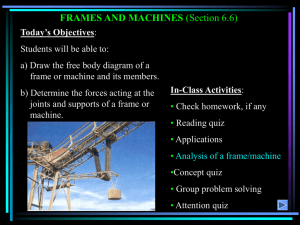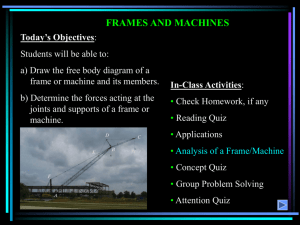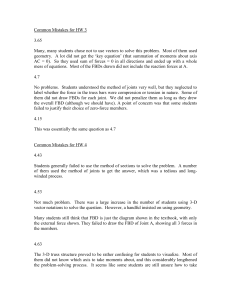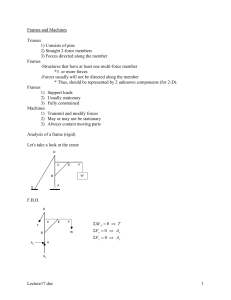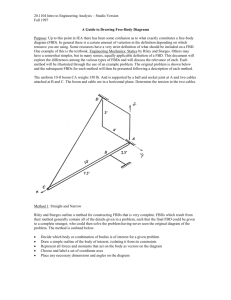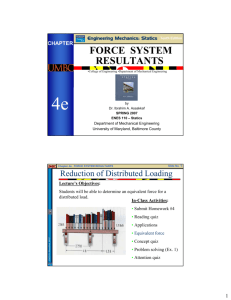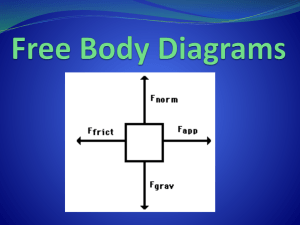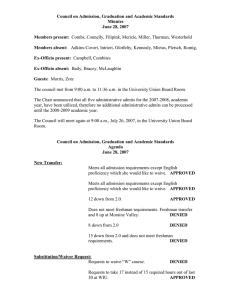Chapter 4b
advertisement
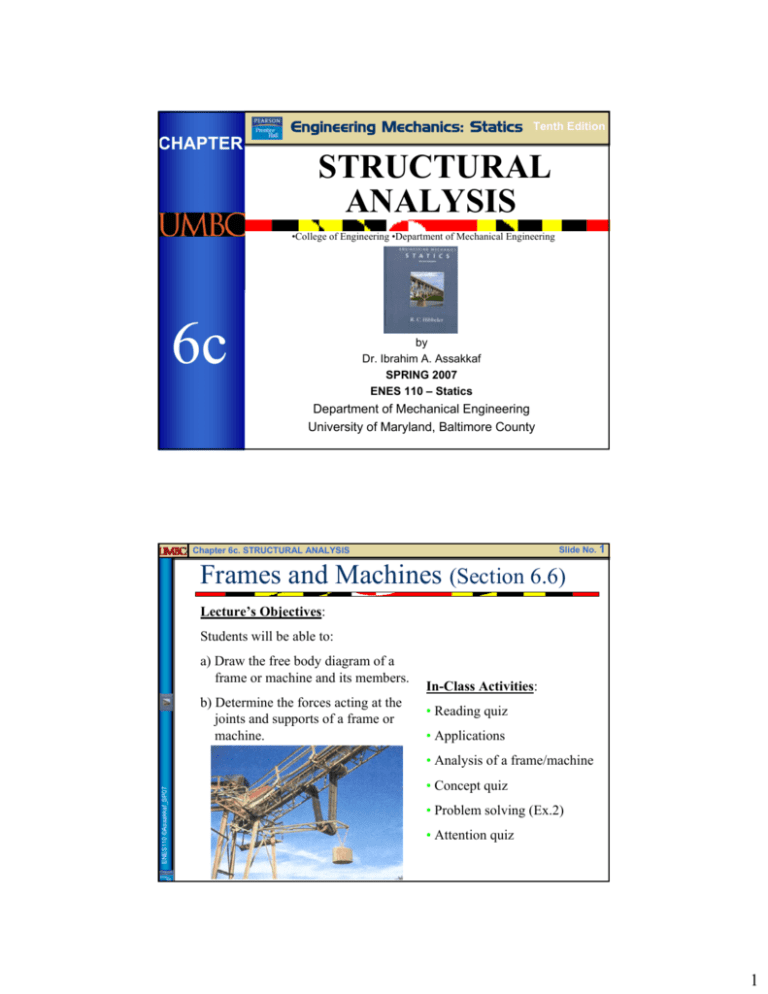
Engineering Mechanics: Statics Tenth Edition CHAPTER STRUCTURAL ANALYSIS •College of Engineering •Department of Mechanical Engineering 6c by Dr. Ibrahim A. Assakkaf SPRING 2007 ENES 110 – Statics Department of Mechanical Engineering University of Maryland, Baltimore County Slide No. 1 Chapter 6c. STRUCTURAL ANALYSIS Frames and Machines (Section 6.6) Lecture’s Objectives: Students will be able to: a) Draw the free body diagram of a frame or machine and its members. b) Determine the forces acting at the joints and supports of a frame or machine. In-Class Activities: • Reading quiz • Applications ENES110 ©Assakkaf_SP07 • Analysis of a frame/machine • Concept quiz • Problem solving (Ex.2) • Attention quiz 1 Slide No. 2 Chapter 6c. STRUCTURAL ANALYSIS Reading Quiz 1. Frames and machines are different as compared to trusses since they have ___________. A) only two-force members B) C) at least one multiforce member D) only multiforce members at least one two-force member ENES110 ©Assakkaf_SP07 2. Forces common to any two contacting members act with _______ on the other member. A) equal magnitudes but opposite sense B) equal magnitudes and the same sense C) different magnitudes but opposite sense D) different magnitudes but the same sense Slide No. 3 Chapter 6c. STRUCTURAL ANALYSIS Applications ENES110 ©Assakkaf_SP07 Frames are commonly used to support various external loads. How is a frame different than a truss? How can you determine the forces at the joints and supports of a frame? 2 Chapter 6c. STRUCTURAL ANALYSIS Slide No. 4 ENES110 ©Assakkaf_SP07 Applications (cont’d) Machines, like these above, are used in a variety of applications. How are they different from trusses and frames? How can you determine the loads at the joints and supports? These forces and moments are required when designing the machine members. Chapter 6c. STRUCTURAL ANALYSIS Slide No. 5 ENES110 ©Assakkaf_SP07 Frames and Machines: Definitions Frames and machines are two common types of structures that have at least one multi-force member. (Recall that trusses have nothing but two-force members). Frames are generally stationary and support external loads. Machines contain moving parts and are designed to alter the effect of forces. 3 Slide No. 6 Chapter 6c. STRUCTURAL ANALYSIS Steps for Analyzing a Frame or Machine 1. Draw the FBD of the frame or machine and its members, as necessary. ENES110 ©Assakkaf_SP07 Hints: a) Identify any two-force members, b) Forces on contacting surfaces (usually between a pin and a member) are equal and opposite, and, c) For a joint with more than two members or an external force, it is advisable to draw a FBD of the pin. FAB 2. Develop a strategy to apply the equations of equilibrium to solve for the unknowns. Pin B FAB Problems are going to be challenging since there are usually several unknowns. A lot of practice is needed to develop good strategies. Slide No. 7 Chapter 6c. STRUCTURAL ANALYSIS Example 1 Given: The wall crane supports an external load of 700 lb. Find: The force in the cable at the winch motor W and the horizontal and vertical components of the pin reactions at A, B, C, and D. ENES110 ©Assakkaf_SP07 Plan: a) Draw FBDs of the frame’s members and pulleys. b) Apply the equations of equilibrium and solve for the unknowns. 4 Slide No. 8 Chapter 6c. STRUCTURAL ANALYSIS Example 1 (cont’d) FBD of the Pulley E T T E 700 lb ENES110 ©Assakkaf_SP07 Necessary Equations of Equilibrium: ↑+ ∑ Fy = 2 T – 700 = 0 T = 350 lb Slide No. 9 Chapter 6c. STRUCTURAL ANALYSIS Example 1 (cont’d) 350 lb Cy Cx C → + ∑ Fx = Cx – 350 = 0 Cx = 350 lb 350 lb ↑ + ∑ Fy = Cy – 350 = 0 Cy = 350 lb A FBD of pulley C ENES110 ©Assakkaf_SP07 350 lb By Bx B → + ∑ Fx = – Bx + 350 – 350 sin 30° = 0x BX = 175 lb ↑ + ∑ Fy 30° = By – 350 cos 30° = 0 By = 303.1 lb 350 lb A FBD of pulley R 5 Slide No. 10 Chapter 6c. STRUCTURAL ANALYSIS Example 1 (cont’d) Please note that member BD is a twoforce member. TBD Ax A Ay 45° 4 ft 350 lb B 175 lb 303.11 lb 4 ft 700 lb A FBD of member ABC ENES110 ©Assakkaf_SP07 + ∑ MA = TBD sin 45° (4) – 303.1 (4) – 700 (8) = 0 ↑ + ∑ Fy TBD = 2409 lb = Ay + 2409 sin 45° – 303.1 – 700 = 0 Ay = – 700 lb → + ∑ Fx = Ax – 2409 cos 45° + 175 – 350 = 0 Ax = 1880 lb Slide No. 11 Chapter 6c. STRUCTURAL ANALYSIS Example 1 (cont’d) A FBD of member BD 2409 lb D 45° B ENES110 ©Assakkaf_SP07 2409 lb At D, the x and y component are → + Dx = –2409 cos 45° = –1700 lb ↑ + Dy = 2409 sin 45° = 1700 lb 6 Chapter 6c. STRUCTURAL ANALYSIS Slide No. 12 ENES110 ©Assakkaf_SP07 Concept Quiz 1. The figures show a frame and its FBDs. If an additional couple moment is applied at C, then how will you change the FBD of member BC at B? A) B) C) D) No change, still just one force (FAB) at B. Will have two forces, Bx and By, at B. Will have two forces and a moment at B. Will add one moment at B. Chapter 6c. STRUCTURAL ANALYSIS Slide No. 13 Concept Quiz (cont’d) ENES110 ©Assakkaf_SP07 •D 2. The figures show a frame and its FBDs. If an additional force is applied at D, then how will you change the FBD of member BC at B? A) B) C) D) No change, still just one force (FAB) at B. Will have two forces, Bx and By, at B. Will have two forces and a moment at B. Will add one moment at B. 7 Slide No. 14 Chapter 6c. STRUCTURAL ANALYSIS Example 2 Given: A frame and loads as shown. Find: The reactions that the pins exert on the frame at A, B and C. Plan: ENES110 ©Assakkaf_SP07 a) Draw a FBD of members AB and BC. b) Apply the equations of equilibrium to each FBD to solve for the six unknowns. Think about a strategy to easily solve for the unknowns. Slide No. 15 Chapter 6c. STRUCTURAL ANALYSIS Example 2 (cont’d) FBDs of members AB and BC: By B Bx 1000N Bx By B 0.4m 500N Ax C A 45º 0.2m 0.2m 0.2m Cx 0.4m Cy Ay ENES110 ©Assakkaf_SP07 Equating moments at A and C to zero, we get: + ∑ MA = Bx (0.4) + By (0.4) – 1000 (0.2) = 0 + ∑ MC = – Bx (0.4) + By (0.6) + 500 (0.4) By = 0and = 0 Bx = 500 N 8 Slide No. 16 Chapter 6c. STRUCTURAL ANALYSIS Example 2 (cont’d) FBDs of members AB and BC: By Bx Bx B By B 0.4m 1000N 500N Ax C A 45º 0.2m 0.2m ENES110 ©Assakkaf_SP07 Applying EofE to bar AB: 0.2m 0.4m Cy Ay → + ∑ Fx = Ax – 500 = 0 ; Ax = 500 N ↑ + ∑ Fy = Ay – 1000 + 0 = 0 ; Ay = 1000 N Consider member BC: → + ∑ Fx = 500 – Cx = 0 ; Cx = 500 N ↑ + ∑ Fy = Cy Cy = 500 N – 500 = 0 ; Slide No. 17 Chapter 6c. STRUCTURAL ANALYSIS Attention Quiz ENES110 ©Assakkaf_SP07 1. When determining the reactions at joints A, B, and C, what is the minimum number of unknowns for solving this problem? A) 3 B) 4 C) 5 D) 6 2. For the above problem, imagine that you have drawn a FBD of member AB. What will be the easiest way to directly solve for the first unknown? A) ∑ MC = 0 B) ∑ MB = 0 C) ∑ MA = 0 D) ∑ Fx = 0 9
